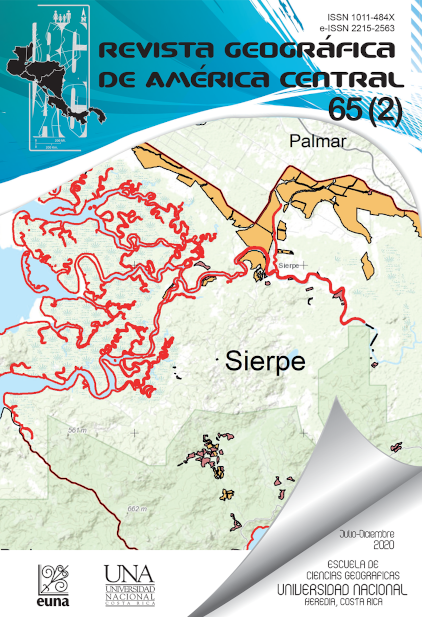Changes in the area cultivated with oil palm in the canton of Osa, Puntarenas. 2014-2018 period
DOI:
https://doi.org/10.15359/rgac.65-2.4Keywords:
Land-use change, GIS, Oil palm, Agricultural frontier, Costa Rica’s Southern ZoneAbstract
Oil palm cultivation shows accelerated growth worldwide. According to official data, the Latin American region alone has seen 150.8% growth of area destined to oil palm cultivation, expanding from 443,000 hectares in 2001 to 1,111,000 hectares in 2014, of which 818,000 hectares were in the harvesting stage whereby contributing to approximately 6% of worldwide palm oil production (González, 2016). Oil palm plantations have impacted tropical landscapes by the decrease of natural vegetation, pastures or by replacing other crops. Oil palm cultivation increased in Costa Rica and, according to the trend of recent years, will continue to rise. In recent years, agricultural censuses and surveys have been carried out that show the general growth of cultivated land but omit to detail the geographical areas of expansion, nor depict the consequent impact on the natural dynamics of the cultivated area; both aspects constitute key information for regional and local territorial planning processes taking place in the country. Thus, the objectives of the present research were: to analyze the change in oil palm cultivated area in the canton of Osa, province of Puntarenas in the 2014-2018 period, and evaluate the expansion of oil palm cultivation in the districts of the canton. Accordingly, data from government institutions were analyzed and the oil palm plantations of the six districts of the Osa canton were identified and digitized.
References
Aldana Dezzeo, A. & Bosque Sendra, J. (2008). Cambios ocurridos en la cobertura/uso de la tierra del Parque Nacional Sierra de la Culata. Mérida-Venezuela. Período 1988-2003, GeoFocus (Artículos), n° (8), p. 139-168, ISSN: 1578-5157.
Allen, E., Edwards, G., y Bédard, Y. (1995). Qualitative causal modeling in temporal GIS”, en Frank y Kuhn (Eds.), Spatial information theory a theoretical basis for GIS (COSIT’95), (397-412). Lecture Notes in Computer Science. Austria, Springer-Verlag.
Beggs, E. & Moore, E. (2013). El Paisaje Social de la Producción de Aceite de Palma Africana en la Región de Osa y Golfito, Costa Rica. San José, Costa Rica. INOGO, Stanford Woods Institute for the Environment.
Briassoulis, H. (1999). Analysis of land use change: Theoretical and modeling approaches. The web Book of Regional Science, Regional Research Institute, West Virginia University. Recuperado de http://www.rri.wvu.edu/WebBook/Briassoulis/.
Brooks, T. & Tobias J. et al. (1999). Deforestation and bird extinctions in the Atlantic forest, Animal Conservation 2, 211-222.
Clare Rhoades, P. (2011). Los cambios en la cadena de producción de la palma aceitera en el Pacífico costarricense: Una historia económica, socioambiental y tecnocientífica, 1950-2007. 1a edición - San José, Costa Rica, Sociedad Editora Alquimia 2000 258 p.; ilus., maps.; 25 x 18 cm.
Challenger, A. (1998). Utilización y conservación de los ecosistemas terrestres de México, pasado presente y futuro. Comisión Nacional para el Conocimiento y Uso de la Biodiversidad, Instituto de Biología, UNAM, Agrupación Sierra Madre S.C., México.
Chuvieco Salinero, E. (2002). Teledetección ambiental. La observación de la Tierra desde el espacio. Barcelona, España, Ariel Ciencia.
Díaz Beltrán, A. (2017). Análisis multitemporal del crecimiento del área sembrada en palma africana (Elaris guincensis) y su efecto en los espacios naturales en la zona de los Llanos Orientales de Colombia. Facultad de Ingeniería. Universidad Militar Nueva Granada.
Dirección Provincial de Ordenamiento Urbano y Territorial (DPOUT). (2011). Sistemas de Información Geográfica para el ordenamiento territorial. Recuperado de http://www.mosp.gba.gov.ar/sitios/urbanoter/sig/Manual_SIG_UT.pdf.
Farfán G., Michelle, G. Rodríguez-Tapia & Mas, J. F. (2016). Análisis jerárquico de la intensidad de cambio de cobertura/uso de suelo y deforestación (2000-2008) en la Reserva de la Biosfera Sierra de Manantlán, México, Investigaciones Geográficas, (90), 89-104. Instituto de Geografía, UNAM, México, http://dx.doi.org/10.14350/rig.48600.
Flather, C.H., Knowles, M.S. & Kendall, I.A. (1998). Threatened and endangered species geography. BioScience (48): 365–376.
Forero, M.C. (1981). Levantamiento de cobertura terrestre y uso de la tierra. Centro Interamericano de Fotointerpretación, Unidad de Suelos y Agricultura. Bogotá, Colombia.
Hansen A.J., DeFries R., Turner W. (2004). Land Use Change and Biodiversity: A Synthesis of Rates and Consequences during the Period of Satellite Imagery. In: Gutman G. and Justice C. (eds.) 2004. Land Change Science: Observing, Monitoring, and Understanding Trajectories of Change on the Earth's Surface. (227-299) Springer Verlag, New York, NY.
Hernández Rojas, D., López Barrera, F. & Bonilla Moheno, M. (2017). Análisis preliminar de la dinámica de uso de suelo asociada al cultivo palma de aceite (Elaris guincensis) en México. Agrociencia 52: 875-893.
Instituto Nacional de Estadística y Censos. (2015). VI Censo Nacional Agropecuario. Atlas Estadístico Agropecuario / Instituto Nacional de Estadística y Censos. -- 1 ed. --San José. Costa Rica.
Instituto Nacional de Estadística y Censos. (2018). Encuesta Nacional Agropecuario. Recuperado de http://www.inec.go.cr/content/encuesta-nacional-agropecuaria-publicacion-de-cultivos-2018.
Jansen, L. y Di Gregorio, A. (2002): "Parametric land cover and land-use classifications as tools for environmental change detection", Agriculture, Ecosystems & Environment, 91, (1-3), 89-101.
Lambin E.F., Geist H.J. & Lepers, E. (2003). Dynamics of land-use and land-cover change in tropical regions. Annual Review of Environment and Resources 28: 205-241.
Lausch, A y Herzog, F. (2002). Applicability of landscape metrics for the monitoring of landscape change: issues of scale, resolution and interpretability. Ecological Indicators, 2, 1-2, 3-16.
Lucke, O. (1986). Escalas y niveles de detalle. Documento del curso de planificación del uso de la tierra. INFORAT, Centro Agronómico Tropical de Investigación y Enseñanza. Turrialba, Costa Rica.
Lucke, O. (1986). Consideraciones básicas sobre la aplicación de metodologías de análisis en la planificación del uso de la tierra y la toma de decisiones. Turrialba, Costa Rica. CATIE. (mimeogr).
Marceau, D., Guindon, L., Bruel, M. y Marois, C. (2001). Building temporal topology in a GIS database to study the land-use changes in a rural-urban environment. Professional Geographer, 53, (4), 546-558.
Marvin Barquero (20 de noviembre de 2018). Café, palma aceitera y caña de azúcar son los cultivos con más área en Costa Rica. La Nación. Recuperado de https://www.nacion.com/economia/agro/cafe-palma-aceitera-y-cana-de-azucar-son-los/KS4WMY6R3ZDOJL3BJO2UWRYFHI/story/.
Ministerio de Ambiente, Energía y Telecomunicaciones. (2011). Diagnóstico sector energía de Costa Rica. VI Plan Nacional de Energía 2012-2030.
Ministerio de Agricultura y Ganadería. (2008). Plan estratégico de la cadena productiva: Palma Aceitera. Período 2008-2010. Recuperado de http://www.mag.go.cr/bibliotecavirtual/E70-4277.pdf.
Mingorance, F., Minelli, F. & Le Du, H. (2004). El cultivo de la Palma Africana en el Chocó. Legalidad Ambiental, territorial y Derechos Humanos. Human Rights Everyhere. Diócesis de Quibdó.
Ochoa, S. y González, M. (2000). Land use and deforestation in the highlands of Chiapas, Mexico. Applied Geography, 20, 17-42.
Pan, W., Walsh, S., Bilsborrow, R., Frizzelle, B., Erlien, C. & Baquero, F. (2004). Farm-level models of spatial patterns of land use and land cover dynamics in the Ecuadorian Amazon”, Agriculture, Ecosystems & Environment, 101, 2/3, 117-135.
Perea Álvarez, R., Mayor Salazar, J. (2014). La cartografía como instrumento de comunicación en la planificación del espacio geográfico. Entorno Geográfico N°(10), 180-193.
Perz, S. y Skole, D. (2003). "Social determinants of secondary forests in the Brazilian Amazon", Social Science Research, 32, (1), 25-61.
Pirker, J., Mosnier, A., Kraxner, F., Havlik, P. & Obersteiner, M. (2016). What are the limits to oil palm expansion? Global Environmental Change 40 (1):73-81. https://ac.els-cdn.com/S0959378016300814/1-s2.0-S0959378016300814-main.pdf?_tid=bb75db78-b556-499d-ac49-4f7390aa8382&acdnat=1548692588_dfd507792e960a53f2106c9650f2e137.
Pontius, R., Shusas, E. & McEachern, M. (2004). Detecting important categorical land changes while accounting for persistence, Agriculture, Ecosystems & Environment, 101, 2/3, 251- 269.
Redacción-Vivir. (2019). Noruega, primer país en prohibir aceite de palma que causa deforestación. El Espectador. Recuperado de https://www.elespectador.com/noticias/medio-ambiente/noruega-primer-pais-en-prohibir-el-aceite-de-palma-que-causa-la-deforestacion-articulo-833082.
Seto, K., Woodcock, C., Song, C., Huang. X., Lu, J., & Kaufmann, R. (2002). Monitoring land-use change in the Pearl River Delta using Landsat TM, International Journal of Remote Sensing, 23, 10, 1985–2004.
Soto Méndez, M. (2018). Crisis de la palma aceitera oprime a productores de Costa Rica. Especial Palma al Límite. Series de Mongabay. Recuperado de https://es.mongabay.com/2018/11/palma-de-aceite-crisis-productores-costa-rica.
Taylor, J., Brewer, T. y Bird, A. (2000). Monitoring landscape change in the National Parks of England and Wales using aerial photo interpretation and GIS, International Journal of Remote Sensing, 21, (13), 2737-2753.
Turner, M., Pearson, S., Bolstad, P. & Wear, D. (2003). Effects of land-cover change on spatial pattern of forest communities in the Southern Appalachian Mountains (USA), Landscape Ecology, 18, (5), 449-464.
Velázquez, A., Mas, J. F., Díaz-Gallegos, J. R., Mayorga-Saucedo, R., Alcántara, P. C., Castro, R., Fernández, T., Bocco, G., Ezcurra, E. & Palacio, J. L. (2002). Patrones y tasas de cambio de uso del suelo en México. Gaceta 62: 21-37.
Vitousek, P. M., Mooney, H. A., Lubchenco, J. & Melillo, J. M. (1997). Human domination of Earth´s ecosystems. Science 277, 494-499.
Xiuwan, C. (2002). "Using remote sensing and GIS to analyse land cover change and its impacts on regional sustainable development", International Journal of Remote Sensing, 23, (1), 107-125.
Downloads
Published
How to Cite
Issue
Section
License
Proposed policy for journals offering Open Access
Authors publishing their works in the Journal acknowledge and agree to the following terms:
a) Authors retain the copyrights to their works and guarantee the Journal the right to be the first to publish their works, under the Creative Commons License Attribution-NonCommercial-ShareAlike 4.0 International, CC BY-NC-SA 4.0 International (https://creativecommons.org/licenses/by-nc-sa/4.0/deed.es), which allows others to share works upon complying with the acknowledgment of authorship and mention of the Journal as the original publisher of the work.
b) Authors are permitted to separately establish additional agreements for the non-exclusive distribution of the official edition of the work published in the Journal (for example, authors may desire to place the work in an institutional repository or incorporate it into a book that is to published elsewhere) so long they acknowledgment to recognize the Journal as the original publisher. The aforementioned additional agreements must respect the terms of the non-profit character and sharing philosophy of the original license (CC BY-NC-SA 4.0 International, https://creativecommons.org/licenses/by-nc-sa/4.0/deed.es).
c) Authors are encouraged to archive the post-print or editor/PDF version in Open Access repositories.







 REVGEO is licensed under https://creativecommons.org/licenses/by-nc-sa/4.0/deed.es
REVGEO is licensed under https://creativecommons.org/licenses/by-nc-sa/4.0/deed.es
.svg_4.png)

_(1).png)
_(1)_(1)_(1)_1.png)
(2)(1)(1)(1).png)
